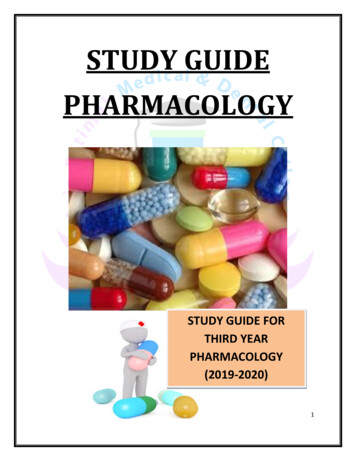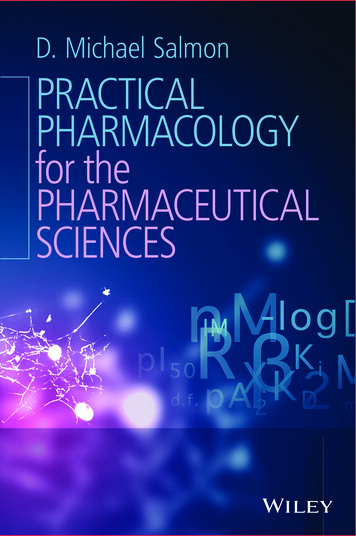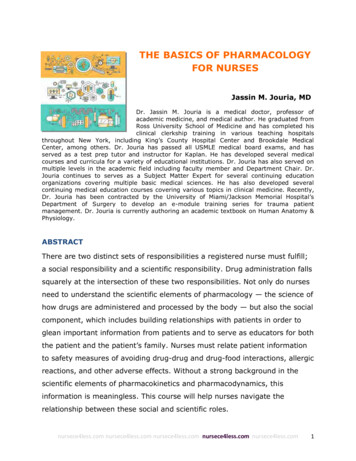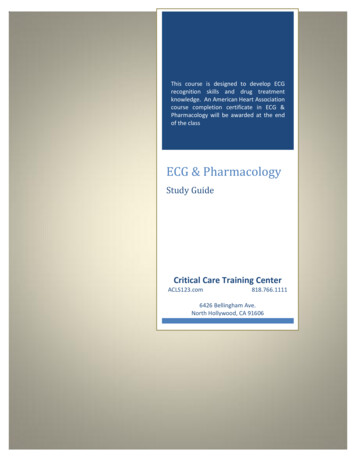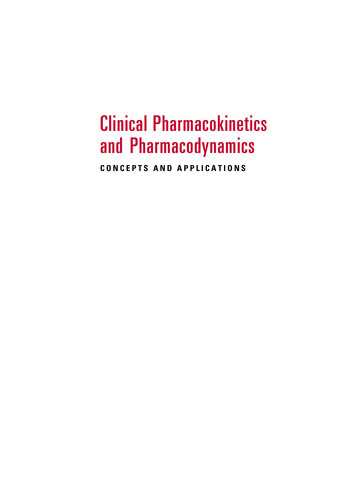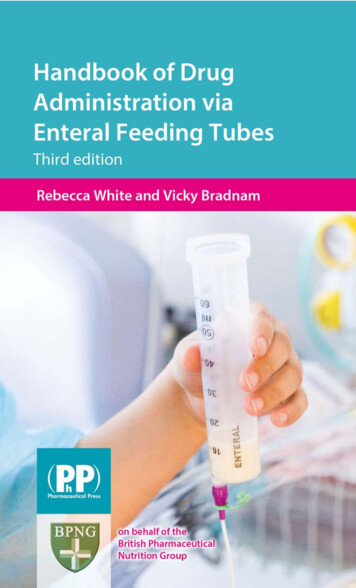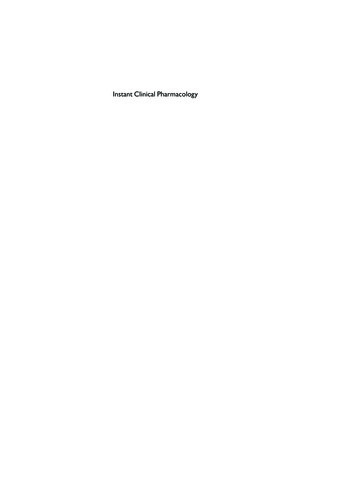
Transcription
ICPA01 21/5/05 12:12 PM Page iInstant Clinical Pharmacology
ICPA01 21/5/05 12:12 PM Page ii
ICPA01 21/5/05 12:12 PM Page iiiInstant ClinicalPharmacologyEvan J. BeggBSc, MB, ChB (Auckland), MD (Otago), FRACPProfessor in Medicine/Clinical PharmacologyChristchurch School of MedicineUniversity of OtagoChristchurchNew Zealand
ICPA01 21/5/05 12:12 PM Page iv 2003 by Blackwell Publishing LtdBlackwell Publishing, Inc., 350 Main Street, Malden, Massachusetts 02148-5018, USABlackwell Publishing Ltd, Osney Mead, Oxford OX2 0EL, UKBlackwell Publishing Asia Pty Ltd, 550 Swanston Street, Carlton, Victoria 3053, AustraliaBlackwell Verlag GmbH, Kurfürstendamm 57, 10707 Berlin, GermanyThe right of the Author to be identified as the Author of this Work has been asserted in accordancewith the Copyright, Designs and Patents Act 1988.All rights reserved. No part of this publication may be reproduced, stored in a retrieval system, ortransmitted, in any form or by any means, electronic, mechanical, photocopying, recording orotherwise, except as permitted by the UK Copyright, Designs and Patents Act 1988, without theprior permission of the publisher.First published 2003 by Blackwell Publishing LtdISBN 1-4051-0275-6Catalogue records for this title are available from the British Library and the Library of CongressSet in 9/12pt Sabon by Graphicraft Limited, Hong KongPrinted and bound in Great Britain by MPG Books Ltd, Bodmin, CornwallCommissioning Editor: Fiona GoodgameProduction Editor: Julie ElliottProduction Controller: Chris DownsFor further information on Blackwell Publishing, visit our website:www.blackwellpublishing.com
ICPA01 21/5/05 12:12 PM Page vContentsIntroduction, viWhat is clinical pharmacology?, viiInducers of drug metabolism/inhibitors ofdrug metabolism, 52Drug/food interactions, 541 Clinical pharmacokinetics, 1General overview of pharmacokinetics, 2Pharmacokinetics, 4Drug clearance, 6Volume of distribution, 8The half-life, 10Oral availability, 12Protein binding, 14pH and pharmacokinetics, 164 Pharmacovigilance, 57Drug development, 58Therapeutic drug monitoring (TDM), 60Drugs involved in therapeutic drugmonitoring, 62Overdose/poisoning, 64Common poisonings, 66Pharmacological aspects of drugdependence, 682 Factors affecting dosing, 19Drug metabolism, 20Saturable metabolism, 22Pharmacogenetics, 24Dosing in liver disease and other diseasestates, 26Renal drug elimination, 28Dosing in renal impairment, 30Dosing in the elderly, 32Dosing in children, 34Drugs in pregnancy, 36Drugs in human milk, 385 Optimal therapeutics, 71Principles of drug action, 72Applied pharmacology, 74Compliance with medication, 76Principles of therapeutics, 78Patients and their drugs, 80The drug profile, 82Evidence-based medicine, 84Pharmacoeconomics, 86Drug information/resources, 886 Appendix, 91Important equations in pharmacology, 92The pharmacokinetic triangle, 93Glossary/abbreviations, 94Test questions, 96Test answers, 983 Altered drug effect, 41Adverse drug reactions, 42Drug-induced allergy, 44Adverse drug events, 46Preventing adverse drug events, 48Drug/drug interactions, 50Index, 101v
ICPA01 21/5/05 12:12 PM Page viIntroductionAny feedback would be appreciated, particularly in terms of improving the userfriendliness of the book.I acknowledge with warm gratitude theinput and inspiration of all the members ofmy department, both past and present. Thebook is dedicated to my students, whosehumour and wide-eyed enthusiasm makesteaching so worthwhile.This book is written mainly for medical students and doctors undergoing postgraduatetraining. Students of allied health professionals, such as pharmacy, nursing, dentistryand physiotherapy may also find it useful.The aim is to provide essential information about the core topics in clinical pharmacology. There is general agreement acrossthe world about what constitutes this corecurriculum. These topics are covered, theemphasis reflecting my own biases.The book assumes a knowledge of basicpharmacology and does not embrace specific therapeutics. It aims to bridge the gapbetween basic pharmacology and the therapeutic use of drugs in humans.Some readers may be put off by theslightly mathematical nature of the initialsection on clinical pharmacokinetics. I apologize for this, but unfortunately this is thebasis of clinical pharmacology. The bookgets easier after this.How to use the bookMindful of the fickle nature of the learningprocess, I have tried to keep things simpleand to encapsulate each topic within twofacing pages. Hopefully, this will enable thereader to complete a topic in a short learning session before the inevitable build-up ofboredom!Happy learning!Evan J. Beggvi
ICPA01 21/5/05 12:12 PM Page viiWhat is Clinical Pharmacology?For example, once a diagnosis has beenmade and drug therapy is considered appropriate, a particular drug must be chosen. Theideal drug is chosen, based on the best evidence. This drug is then examined to see if it isappropriate for this patient. Is the patient allergic to this drug or class? Are there any potential interactions withthe patient’s other drugs? Does the patient have other diseases thatmight be made worse (or better) by the addition of the new drug? Is compliance likely to be a problem?If the drug passes this first test, then a dosageregimen must be chosen. The starting pointis the ‘normal’ dose regimen that would beappropriate for the ‘average’ patient. Thisdosage regimen is then adjusted to tailor itto this patient. Is the patient old? (may need a lower dose) Is there any renal impairment/liver impairment? (may need a lower dose or alonger dose interval) Are there any drug interactions that mightrequire dose alteration?Clinical pharmacology is concerned with therational, safe and effective use of medicines.Clinical pharmacologyThe principles behind the prescribing processas opposed toTherapeuticsThe process of medical treatmentClinical pharmacology involves the complex interaction between the patient and thedrug. The patient is a unique individual,with many distinguishing features that needto be taken into account during prescribing.The patient can be described in terms of thepatient profile. The drug, likewise, is unique,with its own distinguishing features. It maybe described in terms of the drug profile.Good prescribing involves tailoring thedrug and dosing regimen to the unique patient. Clinical pharmacology provides thebasis of this.Problems with these ‘ideals’Patient profileAgeWeightSexRaceAllergiesSmoking historyAlcohol historyDiseasesPregnant/lactatingCurrent therapyIntelligenceDrug profileName traindications/precautionsInteractionsSide effectsDosing regimenMonitoringOverdoseIt is easy to preach a ‘holier than thou’approach to therapeutics, but harder toachieve this in practice. Individualizingdrugs to the patient may be different indifferent settings. Prescribing in outbackAustralia is likely to be very different fromprescribing in central Sydney. Access tolaboratories and medical follow-up will bedifferent. The ideal drug, based on evidence,may be totally impractical for your particular patient.vii
ICPA01 21/5/05 12:12 PM Page viiiWhat is Clinical Pharmacology?to respect the patient’s choice. The word‘rational’ is relevant here, denoting not onlyscientific rationality, but also situationalrationality.The ‘rational, safe and effective use ofmedicines’ must be tolerant of all this. Prescribers should not be expected to achieveperfection, but to pursue the greatest possible effectiveness, with minimal risks, andviii
ICPC01 21/5/05 12:15 PM Page 11 Clinical pharmacokineticsGeneral overview of pharmacokinetics, 2Pharmacokinetics, 4Drug clearance, 6Volume of distribution, 8The half-life, 10Oral availability, 12Protein binding, 14pH and pharmacokinetics, 161
ICPC01 21/5/05 12:15 PM Page 2Clinical pharmacokinetics1General Overview of PharmacokineticsGeneral Overview ofPharmacokineticsThe aim of drug therapy is to achieve efficacy without toxicity. This involves achieving a plasma concentration (Cp) that is abovethe minimal effective concentration (MEC),but below the minimal toxic concentration(MTC).Clinical pharmacokinetics is about all thefactors that determine the Cp and its timecourse, i.e. it is about variability. The various factors are dealt with in subsequentchapters.In order to achieve early effect (e.g. treatingstatus epilepticus with phenytoin) it is important to get the Cp up to the effect zone assoon as possible. This is achieved with aloading dose.The factor determining the loading dose isthe volume of distribution (Vd).Oral dosingMTCConstant IV infusionMECCpMTCCpSSCpMECDoseTimeDose DoseTimeDoseThe curve reflects assimilation and elimination, and intermittent administration.The Cp rises to reach the desired steady stateconcentration (CpSS). The main determinantof the CpSS is the dose and the clearance (Cl).Cp higher than desiredLoading dose (IV injection followed by aconstant infusion)MTCCpSSCpMECMTCCpSSCpMECTimeThe two factors involved are excessive dosage and/or decreased Cl.Time2
ICPC01 21/5/05 12:15 PM Page 3General Overview of Pharmacokinetics Clinical pharmacokineticsFactors causing decreased Cl are:normal variationsaturable metabolismgenetic enzyme deficiencyrenal failureliver failureold agevery young age (neonate)enzyme inhibition.This is determined by the t1/2 of the drug. Ittakes 4 t1/2 to achieve 90% of the steadystate concentration.Time for drug eliminationMTC1.0CpCp lower than desiredDrug stoppedMTC–1 00.250.1251 2 3Half-livesCpSSCpMEC0.50.062545MECThis is determined by the t1/2 of the drug. Ittakes 4 t1/2 for concentrations to reduce to 10% of the starting value.TimeComponents of the line ofsteady stateDose may be too low, or Cl too high.Factors causing increased Cl are: normal variation poor absorption high first-pass metabolism genetic hypermetabolism enzyme induction non-compliance.CpSSCpTime to steady state01234Half-lives56MTCCpThe line of steady state is effectively made upof the sum of the line of accumulation andthe line of elimination. i.e. the net effect ofinput and output.MEC01234Half-lives5631
ICPC01 21/5/05 12:15 PM Page 4Clinical f the body. From a dosing point of view itis the concentration of drug at the site ofaction that is important. This is difficult tomeasure. Under steady-state conditions theplasma concentration (Cp) is in equilibriumwith sites of action. In practice it is usuallythe Cp that is measured.Pharmacokinetics:The study of the movement of drugs into,within and out of the bodyi.e. what the body does to the drugas opposed toPharmacodynamics:The study of drug effect, andmechanisms of actioni.e. what the drug does to the bodyCpIt is important to know the pharmacokinetics of a drug so that the drug can be used in arational and scientific manner, and the dosetailored to the patient.The most important pharmacokineticparameters from a dosing point of view arethe clearance (Cl), the volume of distribution (Vd) and the half-life of elimination(t1/2). The Cl determines the maintenancedose, the Vd the loading dose, and the t1/2 thedose interval.CbiophaseReceptorsSite of action (biophase)The pharmacokinetics of a drug are usuallystudied using an intravenous injection orinfusion, as the dose can then be consideredto be 100% assimilated into the body. Thevalues of Cl, Vd and t1/2 for a drug are derivedfrom the curve of concentration versus time.Zero-order eliminationIt would be very simple if the Cp declinedlinearly with time after a simple intravenousinjection. This situation, called zero-orderelimination, occurs only rarely. A familiarexample is ethanol, concentrations of whichdecline at a constant rate of approximately15 mg/100 mL/h.One-compartment modelThe most simple model is the one-compartment model. In this, the body is consideredas a single container (one compartment) inwhich the drug is instantaneously and uniformly distributed.Input(dose)(NB linear scale)Drug inbodyCpOutput(elimination)Pharmacokinetics involves the study of themovement of the drug into, within and outTime4
ICPC01 21/5/05 12:15 PM Page 5PharmacokineticsClinical pharmacokineticswhere Cpt is the concentration at any time tCpo is the concentration at time zeroand k is the elimination rate constantThis equation is difficult to use (for mostof us!) and can be simplified by transformingit to a linear expression. This is done by taking the natural logarithm of each side:First-order eliminationThe more common situation is first-orderelimination, in which the decline in plasmaconcentrations is not constant with time, butvaries with the concentration. The higherthe concentration, the greater the rate ofelimination. The concentration declines ‘exponentially’ with time.ln Cpt ln Cpo ktThis now has the form of a linear equationy mx c, or in this case because the line isdeclining, y c mx, where m is the slopeand c the intercept on the y-axis.(NB linear scale)Cp(NB log scale)CpoFirst-order eliminationk(In) CpTimeThis curve can be described by:Cpt Cpo * e ktTimeImportant pharmacokinetic initiont1/2VdClAUCFfuPBTmaxCmaxthe half-life of eliminationVolume of distributionClearanceArea under the curveFractional oral availabilityfraction excreted unchangedProtein BindingTime to maximum concentrationPeak concentration(Concentration maximum)ssCpCptCpoCpssAbeSteady statePlasma concentrationPlasma concentration at time tPlasma concentration at time oPlasma concentration at steady stateAmount in bodyThe natural logarithm(value 2.7183)log to the base ethe rate constant of eliminationlnk51
ICPC01 21/5/05 12:15 PM Page 6Clinical pharmacokineticsDrug ClearanceDrug Clearance1i.e. rate of elimination Cl * CpDrug clearance (from plasma) is defined as:‘The volume of plasma cleared of drugper unit time’;or‘A constant relating the rate of elimination tothe plasma concentration (Cp)’i.e. rate of elimination Cl * CpUnits: vol/time (e.g. L/h)Thus, Cl is ‘A constant relating the rate ofelimination to the plasma concentration’;and‘The volume of plasma cleared of drug perunit time’.The equation can be rearranged asfollows:Clearance (Cl) is the single most importantpharmacokinetic parameter. Cl determinesthe maintenance dose-rate, i.e. dose per unittime, required to maintain a plasma concentration.Clearance does not apply to drugs withzero-order kinetics, but only to those withfirst-order (exponential) kinetics. This appliesto the majority of drugs.Cl (L/h) Cp (mg/l)Achievement of a constant steadystate plasma drug concentration(CpSS)In order to maintain a target Cp, the drugmust be administered at a rate equal to therate of elimination at that concentration, i.e.(NB linear scale)Cprate of elimination (mg/h)rate of administration rate of eliminationSincerate of elimination Cl * Cp, thenrate of administration Cl * CpSS, orFirst-order eliminationMaintenance dose-rate Cl * CpSSTimeThe graph shows that the rate of elimination(RE) is different at different concentrations,i.e. it is driven by concentration.CpSSrate of elimination Cp rate of elimination (mg/h) constant(L/h) * Cp (mg/L)AdministrationCpEliminationThis ‘constant’ is the clearance (Cl) and bydeduction has units of volume/time (e.g.L/h), since the units for rate of eliminationare mg/h, and for concentration mg/L.061243Half-lives56
ICPC01 21/5/05 12:15 PM Page 7Drug ClearanceClinical pharmacokineticsPhysiological relevance ofdrug clearance1The main organs responsible for drug clearance are the liver (metabolism) and the kidneys (removal of unchanged drug). Totalbody Cl is the sum of all clearance processes,i.e.CpArea1Cl (total) Cl (renal) Cl (liver) Cl (other)234567TimeArea under the curve (AUC)Determination of ClThe bigger the AUC, the smaller the Cl.Plasma Cl is usually determined from thearea under the plasma concentration vs timecurve (AUC) after IV administration.The AUC is determined using the ‘trapezoidal rule’.AUC Area 1 Area 2 Area 3 . . .Area n, where each area is approximated bya trapezium.Cl DoseAUCAfter oral administration:Cl F * DoseAUCwhere F oral availability.7
ICPC01 21/5/05 12:15 PM Page 8Clinical pharmacokineticsVolume of DistributionVolume of Distribution1volume of the body (50–100 L) is comparedwith Vds of drugs, e.g. heparin (5 L); gentamicin (15 L); digoxin (500 L); and quinacrine (20 000 L).Highly lipid soluble drugs such as quinacrine have much larger Vds than very polar,water soluble drugs such as heparin.The volume of distribution is:‘The volume into which a drug appearsto be distributed with a concentrationequal to that of plasma,’or‘A proportionality constant relatingthe plasma concentration (Cp) to theamount of drug in the body (Ab).’i.e. Ab Vd * CpUnits: Volume or vol/kgDetermination of VdTo calculate Vd, the Ab and Cp need to beknown. The only time Ab is known accurately is immediately after the drug has beengiven intravenously (prior to elimination),i.e. the dose. If the Cp at time zero (Cpo) isknown, then the Vd can be calculated. TheCpo can be determined from the lnCp vs timecurve after intravenous (IV) administration.After initial distribution, there is a ‘loglinear’ decline in plasma concentration. TheCpo can be determined by back-extrapolating the linear portion of the curve to its intercept on the y-axis. Vd can then be calculated.The volume of distribution (Vd) is the secondmost important pharmacokinetic parameter(after Cl). It determines the loading dose, i.e.the dose required to achieve a target plasmaconcentration (Cp) as soon as possible.In order to achieve a target Cp, the tissuesinto which the drug distributes (i.e. the volume of distribution) must be ‘filled up’.The Vd is therefore ‘the volume intowhich a drug appears to be distributed witha concentration equal to that of plasma’.After distribution is complete, the amountof drug in the body (Ab) is proportional tothe plasma concentration (Cp).i.e.orCpoAb CpAb constant * CpThis constant has units of volume (e.g. L)since the Ab is in mass units (e.g. mg) and Cpis in concentration units (e.g. mg/L).Hence the Vd is ‘A proportionality constant relating the plasma concentration tothe amount of drug in the body.’i.e.or(In) CpTimeAb Vd * cpVd i.e. At time zero, Ab dosethen dose Vd * Cpoor Vd dose/CpoAbCpCalculation of loading dose (LD)The Vd is often called the ‘apparent’ Vdsince the volume has no real anatomicalmeaning. This can be appreciated when theIt follows from the above that to achieve atarget Cp, the Vd of the drug must be known8
ICPC01 21/5/05 12:15 PM Page 9Volume of DistributionClinical pharmacokineticsCurve A a loading dose followed by maintenance dosing.Curve B a maintenance dosing everyhalf-life.In summary, the most important thingabout Vd is that it enables the calculation ofa loading dose to achieve any desired Cp.LD Vd * target Cpe.g. to achieve a target Cp of digoxin (Vd 500 L) of 1.5 µg/L, a loading dose (LD) of750 µg, or 0.75 mg is needed, i.e.LD (µg) 500 (L) * 1.5 (µg/L) 750 µgLD Vd * CpWith a loading dose, steady-state concentrations can be achieved quickly.2.0A1.5Cp 1.00.75B0.5line of0.875 steady-state0.50.001234Time (units of t1/2)591
ICPC01 21/5/05 12:15 PM Page 10Clinical pharmacokineticsThe Half-LifeThe Half-Life1Time-course of drug eliminationThe half-life of elimination (t1/ 2) is:‘The time for the concentration ofthe drug in plasma (or the amount ofdrug in the body) to halve.’Units: Time (usually h)If a drug is discontinued after an infusion,the Cp will decline exponentially to 10% ofits starting value after four half-lives.The t1/2 provides an index of:1 the time-course of drug elimination;2 the time-course of drug accumulation; and3 choice of dose interval.1.0Cp0.5Drug stoppedDerivation of t1/2The half-life of elimination (t1/2) can bederived by plotting actual concentrations onsemilog graph paper, or logged concentrations on linear graph paper. It is the timetaken for any concentration to halve, e.g.from 3 to 1.5 mg/L.–10.1251 2 3Half-lives0.062545Time-course of drug accumulationIf a drug is started as a constant infusion, theCp will accumulate to approach steady-state( 90% of steady state concentration) afterfour half-lives.(NB log scale)654Cp 3200.25CpSS1.5t1/2 2.5 h1Cp01234Time (h)5670101234Half-lives56
ICPC01 21/5/05 12:15 PM Page 11The Half-LifeClinical pharmacokineticsComponents of the line ofsteady stateRelationship between t1/2, Vd and Cl1The line of steady state is effectively the combination of accumulation and elimination.i.e. it is the sum of the effect of dose and elimination at any time point.larger Vd(In) Cplarger ClCpSSTimeAccumulationCpIt is logical that the larger the Vd, the longerthe t1/2, i.e. it takes longer to remove drugfrom deep within the tissues. Similarly, it islogical that the larger the Cl, the shorter thet1/2. In other words:Elimination01243Half-lives56t1 / 2 Choice of dose intervalThe dose interval is usually chosen based on:1 the t1/22 the therapeutic index of the drug3 compliance a it is best, if possible, to havedosing once or twice a day.If drug Cl decreases (say in renal dysfunction), it may be possible for a drug that isnormally given three or four times a day to begiven twice or once daily, with greater chanceof compliance. This is good therapeutics.VdClThis relationship can be turned into an equation by multiplying the right side by 0.693.This strange number is the natural logarithmof 2 (i.e. ln 2) and gets into the equationbecause the t1/2 involves a halving, i.e. theinverse of 2.t1/2 0.693VdClThis is one of the most important equationsin clinical pharmacokinetics. It indicates that the t1/2 is dependent on Vdand Cl. Vd and Cl are the independent variables.11
ICPC01 21/5/05 12:15 PM Page 12Clinical pharmacokineticsOral AvailabilityOral Availability1AbsorptionOral availability is:The fraction of drug that reaches thesystemic circulation after oral ingestionThis refers to the ability of the drug to crossa biological barrier into the blood. In thecase of oral absorption, it refers to crossingthe gut wall into the portal circulation.Absorption is usually a passive process governed by the principles of diffusion (i.e. flowsdown a concentration gradient). Sometimes,active transport is involved (e.g. l-dopa).Factors favouring absorption include highlipid solubility and low ionization. pH mayalso influence absorption, but probablyaffects the rate more than the extent.Oral availability defines how much drug gets‘on board’ after oral ingestion. ‘Absorption’and ‘first-pass’ metabolism are the maindeterminants of oral availability.Oral availability is usually defined bycomparison with the total availability ofdrug in the systemic circulation after IV dosing, i.e. the fraction (F) of drug that gets intothe body after oral (po) versus IV administration:i.e.F AUC poFirst-pass metabolismAUCIVThis refers to metabolism of the drug priorto reaching the systemic circulation, i.e.presystemic elimination. Some drugs, suchas highly lipid-soluble drugs, are so highlymetabolized that on ‘first-pass’ through theliver there is substantial ‘presystemic’ elimination. Presystemic elimination can occurin the gut wall (e.g. oestrogens), in the portalcirculation (e.g. aspirin salicylic acid) orin the liver (the majority).The total amount of drug in the systemiccirculation is defined by the area underthe concentration–time curve (AUC). TheAUC may be different after oral comparedwith IV administration. The oral availability may have a value of one, or less thanone.AUCIVEffect of food on oral availabilityCpInterestingly, food affects absorption andfirst-pass metabolism in opposite ways. Foodusually decreases the oral availability ofsparingly lipid-soluble drugs that are subjectto absorptive problems, e.g. food decreasesthe oral availability of atenolol by 50%.However, food usually increases the oralavailability of drugs that are subject to highfirst-pass metabolism. This is because foodincreases portal venous blood flow, therebyincreasing the presentation of absorbed drugto the liver, partially saturating metabolizingAUCpoTimeDeterminants of oral availability1 Absorption.2 First-pass metabolism.12
ICPC01 21/5/05 12:15 PM Page 13Oral AvailabilityClinical pharmacokineticspathways and opening up shunts that bypass metabolizing pathways. The net resultis greater oral availability, e.g. food increasesthe oral availability of metoprolol by 50%.Some foods, e.g. grapefruit juice, competewith drugs for presystemic elimination,thereby causing increased oral availability ofthe drug (e.g. calcium antagonists, somestatins).Cmax (peak concentration)1CpTmax (time to peak concentration)TimeTmax is less important than the total oralavailability. A short Tmax may be usefulwhere an immediate effect is desired, e.g.analgesia for a headache. A short Tmax mayalso be a problem e.g. adverse effects relatedto the peak concentration.Confusing terminologyThere is sometimes confusion between theterms ‘oral availability’, ‘bioavailability’and ‘absorption’. Oral availability is the preferred term because it is unambiguous.‘Bioavailability’ has a strict historicaldefinition a ‘the rate and extent of absorption’. One problem with ‘bioavailability’ isits reference to absorption. As noted above,absorption is only one part of the process ofdrug attaining the systemic circulation. Theother problem with ‘bioavailability’ is that itis a single term that defines two processes athe rate of absorption, and the extent. It ismore instructive to think of each of thesecomponents independently, i.e. oral availability defines the extent, and another term,Tmax, defines the rate.Slow-release preparationsA delayed Tmax and a longer drug action maybe achieved using tablets or capsules designed to release their contents slowly. Thisflattens the concentration–time profile, givinga more even drug response.Slow-release preparation(lower Cmax, delayed Tmax)CpTime to peak concentration (Tmax)Tmax defines the time to maximum(or peak) concentrationTime13
ICPC01 21/5/05 12:15 PM Page 14Clinical pharmacokineticsProtein BindingProtein Binding1The major message about protein binding(PB) is that it is usually not important.concentration of free drug, not total drug,that is actually important in terms of desiredeffects and side effects.Free drug concentration is dependent onfree drug clearance (see Clearance, page 6),and does not vary in relation to changes inplasma proteins. Therefore, except for rareexceptions, no alteration in dosage is requiredin states of altered protein binding.Protein binding is only important in theinterpretation of measured plasmaconcentrationsThere is enormous confusion about theimportance of protein binding and the drugeffects attributed to it. While drugs may displace each other from protein-binding sites,this is almost always unimportant. Mostalleged protein binding interactions of clinical importance have an additional mechanism operating, such as altered drugclearance, that is the reason underlying theobserved clinical effects.Acidic drugs bind largely to albumin.Basic drugs bind mainly to α1-acid glycoprotein (i.e. orosomucoid), an acute phase reactant, and to albumin and β-lipoproteins.The significance of protein binding lies inthe interpretation of plasma concentrationsof drugs. If plasma concentrations are notmeasured, protein binding can largely beignored.NB: When plasma concentrations of drugsare measured, it is total drug, i.e. bound unbound, that is measured. It is possible, butnot routine (except perhaps for phenytoin),to measure free or unbound drug.The fallacy of protein-bindingdrug interactionsMany so-called protein-binding drug interactions have been reported. While drugs cancompete for protein binding sites, especiallyon albumin, this does not affect the freeconcentration.This is anartificial‘test-tube’situationWithout displacerIf a drug in the body was not subjectto drug elimination, then introduction of aprotein-binding displacer would increasethe concentration of the free drug.In reality drug elimination does occur.Since the steady-state free drug concentration is only dependent on maintenancedose and free drug clearance (remember,Maintenance dose Cl * Cp), then free drugconcentration returns to its predisplacementlevel. However, the total drug concentrationis now lower than it was.Measured drugBound drugWith displacerFree drugAltered albumin or α1-acid glycoprotein concentrations will alter the measured (total)concentrations of drugs bound highly to theseproteins.However, it is free drug that acts on receptors to produce effect. Therefore, it is the14
ICPC01 21/5/05 12:15 PM Page 15Protein BindingClinical pharmacokineticsFree conc.1 mg/LFree conc.1 mg/L1Totalconc.10 mg/LBoundconc.9 mg/LTotalconc.5 mg/LWithout displacerTotalconc.10 mg/LFree conc.1 mg/LBoundconc.9 mg/LTotalconc.5 mg/LBoundconc.4 mg/LWith displacerNormalalbuminaemia(i.e. 90% PB)Interpretation of measured plasmaconcentrations during therapeuticdrug monitoringFree conc.1 mg/LBoundconc.4 mg/LMarkedhypoalbuminaemia(i.e. 80% PB)Drugs with saturable proteinbindingProtein binding ‘problems’ arise from thefact that the measured drug concentration istotal drug (bound unbound). In hypoalbuminaemia (e.g. in renal disease) an acidic drugsuch as phenytoin will have a lower total drugconcentration because of lower protein binding. Free drug concentration will, however, bethe same as in the non-hypoalbuminaemicstate (assuming free drug Cl is constant).The same principles apply with displacingdrugs in normoalbuminaemia. e.g. phenytoin(therapeutic range 10–20 mg/L total concentration, 1–2 mg/L free concentration).In hypoalbuminaemia free concentration(and effect) is identical but total measuredconcentration is half. If the dose was increased to give a total concentration of10 mg/L, the free concentration would be2 mg/L and may be toxic. Note that th
between basic pharmacology and the thera-peutic use of drugs in humans. Some readers may be put off by the slightly mathematical nature of the initial section on clinical pharmacokinetics. I apo-logize for this, but unfortunately this is the basis of clinical pharmacology. The book gets easier after this. Any feedback would be appreciated, par-
